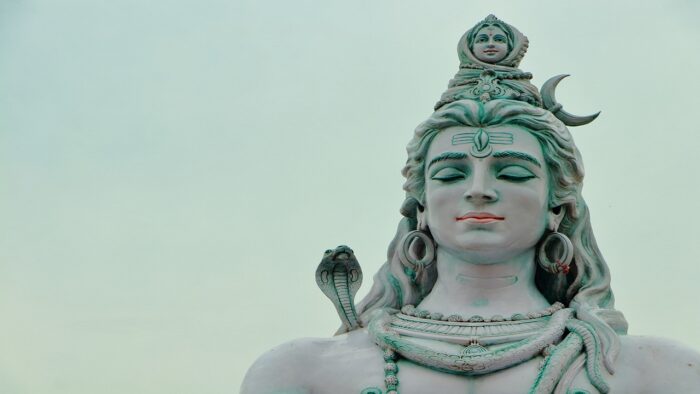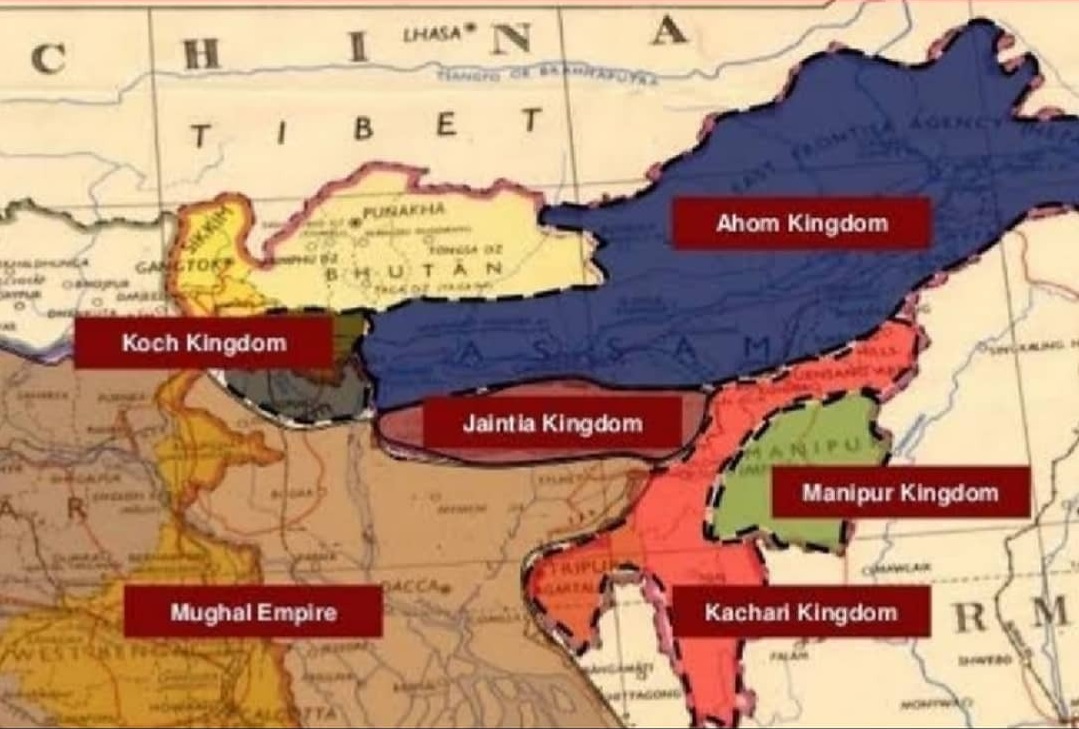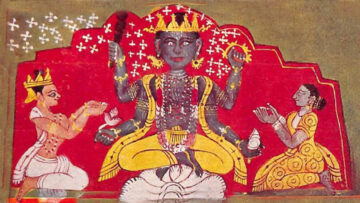The tradition of Siva worship in Assam-Kamarupa dates back to the seventh century AD, to the time of the Varman kings, particularly Bhaskar Varman, who is described in Banabhatta’s seventh-century work Harsa-Carita as an ardent devotee of Siva. In the seventh chapter of the biographical work, there is a reference to the Kamarupa king, where it is stated that, “from childhood upwards it was this prince’s firm resolution never to do homage to any being except the lotus feet of Çiva” (217). As is the case with most eastern languages of India, including Assamese, the first written specimen in the vernacular appears in the form of the Charyapadas composed between the ninth and twelfth centuries. Therefore, for the period of Assam history spanning from the fifth till about the thirteenth century, the major sources of political and literary–cultural documentation comprise: (i) the copper-plate inscriptions, (ii) stone inscriptions, (iii) sectarian religious texts in Sanskrit, and (iv) oral traditions (Sarma-Doloi 86).
In one of these early copper-plate inscriptions, known as the Nidhanpur Copper Plates of Bhaskar Varman (issued sometime between AD 620 and AD 643), the opening plate contains an invocation to Shiva which is as follows:
“Om pranamyadevamshashisekharampriyampinakinambhasmakanairbibhusitam”
(Salutations to the God, who wears the moon as the crest-jewel, who is lovely, who holds the pinaka bow and who is decorated with particles of ashes [Sharma 50])
The devotion to Siva in Assam is closely aligned with Saktaism, the mother goddess sect, and, by extension, with tantricism. Saivism, as a devotional culture, existed in the region prior to the propagation of the Sakti sampradaya, as attested by the Kalika Purana, a Sanskrit purana composed in Kamarupa around the tenth century. The thirty-eighth chapter of the purana describes the religious culture of the inhabitants of Kamarupa of a mythical past when Naraka, the supposed founder of the Bhauma-Varman dynasty, was entrusted by Vishnu to assume of kingship of the region:
“nimajyakshanmatrenapragjyotishpuranggatah/ madhyagangkamarupasyakamakhya yatra nayika// (95) sa cha deshahswarajyarthepurbbangguptaswashambhuna/”
(In an instant, [Naraka and Vishnu] reached Pragjyotishpura, which is located at the centre of Kamarupa and where Kamakhya is the ruling goddess. That very country was earlier kept hidden from view by Shiva for his own sake [my translation]) (Kalikapuranam 318).
With the arrival of Saktaism and possibly also challenging the primacy of Saiva worship in the region, what happened eventually was the fusion of the two traditions, and what we find in Assamese literature is a longstanding and vibrant culture of Sakta–Saiva literary culture during the middle centuries of the second millennium AD. In the case of the Kamarupa kings belonging to the subsequent Salastambha and Pala dynasties (ruling from the seventh to twelfth centuries), allegiance to Siva was mixed with that of Kameswar-Mahagouri thereby reflective of a strong and vibrant mother goddess sect prevailing in the region.
(Figure 1: Credit: Facebook – North-Eastern Empire 17th century, Ahom Dynasty)
Within this context, the present paper undertakes an analysis of the Siva Purana composed by the Ahom king Rudra Singha (reigned 1696–1714). With the fall of the Pala dynasty in AD 1125, the reign of the Kamarupa kings came to an end. What followed was the rise of many new kingdoms and chiefdoms within the political geography of Assam-Kamarupa, including the emergence of the Kamata kingdom on the western part of the region. From the eastern frontier, the Ahoms, who belonged to the Shan tribe of Upper Burma, entered Assam in 1228 and established an empire in the style of a “monarchical oligarchy” which survived for about 600 years, and, subsequently, gave its name to the region. As noted by Diganta Kumar Sarma, “the Ahoms practised Mahayana form of Buddhism combined with elements of animism, Hinayana Buddhism and worshipped a number of gods and goddesses usually with making sacrifices” (243). However, the mid-seventeenth century marked the eventual acceptance of Hinduism (or rather, one of its sectarian forms) as the religion of the Ahom kings, and it was a crucial factor in motivating them to take interest in the language, literature, and culture of Assam as a whole. Initially inclined towards Vaishnavism, the closing years of the seventeenth century, particularly the beginning of the Tungkhungia dynasty (within the Ahoms) in 1681 under the rule of Gadadhar Singha, witnessed the shifting of royal allegiance towards Saktaism and Saivism. His son, Rudra Singha and the author of Siva Purana, however, could sense the danger of favouring one religious sect at the expense of another, and therefore extended his royal patronage to Saktaism, Saivism, and Vaishnavism alike as part of his ruling strategy. At the same time, he was also mindful towards the pan-Indian currents of religious and cultural practices, as practiced by the Mughal and Rajput rulers, and sought to replicate them within his court and kingdom as well. Seen from this perspective, the Siva Purana composed by Rudra Singha was an acknowledgement/indication, on the part of the king, not only of the millennium-long history of royal patronage accorded towards the recognition and dissemination of the Saiva devotional order in Assam, but also of his attempt to connect the region with the pan-Indian expressive cultures, both tangible and intangible.
It may, however, be noted in this regard that this Siva Purana in Assamese by Rudra Singha is not a literal translation or a retelling of the Sanskrit equivalent – the Assamese work instead is a purana in eight cantos each preceded by a Sanskrit sloka and comprising a total of 351 verses. S.N. Sarma notes five important characteristics of a purana: (i) creation (sarga), (ii) recreation (pratisarga), (iii) genealogy (vamsa), (iv) cosmic cycles (manvantara), and (v) accounts of royal dynasties (vamsanucarita) (250). In due course of time, five more characteristics came to be associated with the puranas, namely, vritti (means of livelihood), (ii) raksa (incarnations of gods), (iii) mukti (liberation), (iv) hetu (cause), and (v) apashraya (the last resting place; brahma) (ibid.). In most of the bhasha puranas in Assamese, including the Siva Purana, these characteristics have more or less been preserved (Sarma-Doloi 216). Another important example of an Assamese bhasha purana is Sukabi Narayandeva’a Padmaa Purana, composed in the first half of the seventeenth century and centred on the figure of snake-goddess Manasa, popular across the religious–cultural geographies of Assam and Bengal. In this regard, both Padmaa Purana and Siva Purana could be seen as the response towards the perpetuation of the legacy and grandeur of the cosmopolitan Sanskrit literary culture within the “vernacular” literary cultural space of Assamese. The logic behind Rudra Singha’s division of the Siva Purana into eight cantos could possibly be based on the philosophy of ashtamurti which refers to the eight cosmic bodies of Siva. It is mentioned in the “Vidyeswara Samhita” of the Sanskrit Siva Purana that, corresponding to the eight cosmic bodies, viz., earth (ksiti), water (apas), fire (anala), wind (vayu), ether (akasha), sun (surya), moon (soma), and the sacrificer (yajamana), these manifestations of Siva, namely, Sarva, Bhava, Rudra, Ugra, Bhima, Isvara, Mahadeva, and Pasupati, are worshipped (146). The reference to the eight forms of Siva is also found mentioned in the “Satarudra Samhita” (chapter two). The eighth canto of Rudra Singha’s Siva Purana refers to these cosmic manifestations of Siva as: yoga, dakshina, varuni, kubera (?), patala (?), vaishnavi, agneyi, and nirmalashanta (?) (312–316). Nabin Chandra Sarma notes the particular influence of “Sanatkumar Samhita” of the Sanskrit Siva Purana (297).
The first canto, among other things, describes the panchmurti of Rudra, which draws reference from the “Rudra Samhita” of the Sanskrit Siva Purana. The five murtis or manifestations are described by Rudra Singha in this way:
“prathammurttiyesadakridaka karaya/ dwitiyamurttiyetapasyakeacharaya/ (29) tritiyamurttiyeloka karaya palana/ chaturthamurttiyepraja karaya nashana// panchammurttiyejak brahma bulikoy/ samastejagatjitobyapitaaashoy// (30)”
(The first manifestation forever engages in sport; the second one takes recourse to meditation; the third one looks after [the welfare of] the people; the fourth one indulges in extermination; and fifth one is referred to as Brahma, one who [whose fame] prevails all over the universe [my translation]).
The near corresponding passage in “Rudra Samhita”, as said by Siva, reads thus: “Although Nirguna, I am Saguna too and the author of dissolution, maintenance and creation. I am the supreme Brahman without decay and change. Existence, Knowledge and Bliss are my characteristics” (211). Apart from this, the first canto of Rudra Singha’s purana also undertakes to describe, with Brahma as the narrator, the birth-story (janma-vrittanta) of Rudra, the shrishtitattva as envisioned by Rudra, and the eventual inseparability of Shiva and Brahma. The second canto, a short one, further emphasizes the efficacy of devotion towards Siva and is loosely based on the “Vayaviya Samhita” of the Sanskrit purana. The third canto recounts the narrative regarding Vishnu’s meditation on Siva, based on the “Kotirudra Samhita,” and briefly states the former’s receipt of the sudarshan chakra as a boon from the latter:
“purbattaanekakotihazarbatsar/vishnuyesivakaaradhilatatpar// (64) paserudratustahuyadilaishta bar/ … aamaraagyayetumi chakra dhora kore/ mahabalabantahuyo mora samasare// (65) sivahantepaseehi bar paila/ vishnuyeujagatakapalankorila//.”
The relative primacy of Siva vis-à-vis Vishnu, as emphasized in these lines, is significant from a medieval/early modern Assamese perspective given the widespread popularity of Vaishnavism in the region from about the sixteenth century onwards. Unlike Vaishnavism which developed as a strong sectarian movement called the neo-Vaishnavite movement in Assam under the twin leadership of Sankardeva (1449–1568) and Madhavdeva (1489–1596), there were no concerted efforts on the part of the Sakta or the Saivite poets in Assam to do likewise for their respective sectarian purposes. In this regard, however, one does notice the presence of a group of poets called the Panchali poets who owed allegiance to Manasa, the snake-goddess. These poets, namely, Mankar, Durgabar, Pitambar, Sukabi Narayan (who also composed the Padmaa Purana), and Sastibar, spread over the sixteenth and early seventeenth century, did continue to compose manasageets which were subsequently put into performance by the ojapalis.
Within this context, the composition of the Siva Purana marks an important “textual intervention” in the vernacular thereby emphasizing upon the continuance of the Saiva sampradaya in Assam, despite the missionary enterprise of the neo-Vaishnavite movement. One may even argue that Rudra Singha’s objective behind his endeavour was primarily to stress upon the efficacy of worshipping Shiva, as evident from the “mahatmyabakhyas” (exposition of the greatness) not only of Siva but also of the Siva Purana. A passage in the third canto reads thus:
“ehiaakhyan ji jonesunoyasadaya/ jitonaresuddhahuyamoneyusmaraya// jibajone shraddha koriporheparbbakale/ sehijonebanchitokalabhayasokole// (91)”
(Whoever listens to this saga/tale/narrative every day, whoever remembers/meditates on it with a pure mind, whoever reads it with devotion before embarking on a task, he/she is sure to be granted what he/she has wished for [my translation]).
In this regard, a parallel could be drawn between the chapter on “Sivapurana Mahatmyam” in the Sanskrit text. The fourth canto focuses on Sanatkumar’s devotion towards Siva, his meditation and the eventual receipt of a boon from the god. Considering the particular emphasis on the exalted description of Siva suffused with pauranic metaphors, the parallel representation of him within the oral-performative presents him as a “jatiya-bhangara” (a god with matted locks and under the influence of hemp). A couplet popular within the oja-pali tradition describes Siva in this manner:
“bhakshyanbhangargura naam tripurari/ jagatakadiye dan apunibhikhari//”
(You consume [particles of] hemp, and yet you are known as tripurari; you bestow riches on the whole world, and yet you are a mendicant by yourself [my translation]).
The oral literary culture in Assamese abounded with references to Siva not in the Vedic image of Rudra but in the image of a folk and rustic character, easily identifiable with the loukika imagination of the people. In a way, it could be possible to discern a dual manifestation of Siva – one, puranic/shastraic, and, the other, loukika/folk – in which the oral cultures have, as mentioned, largely depicted the latter image of Siva, while the former found representation through the written culture, including translation works. However, this is not a clear-cut distinction since, in written literatures such as the Manasa Kavya, for instance, the loukika image of Siva is predominant. Within the oral literary tradition of Assam, Siva has variously been represented as a bridegroom, a householder, a farmer, and even as a lusty old fellow. Within the loukika imagination, Siva is also identified as “burha-goshain”; similarly, the Bodos, an important ethnic community of Assam, refer to Siva as “batho,” “bathou,” “bathou-brai,” and “bathou-shivrai” (Nabin Chandra Sarma 137). Therefore, within a cultural geography where the loukika manifestation of Siva finds relatively more acceptance, the challenge for Rudra Singha (himself a king belonging to a dynasty which has only recently embraced Hinduism) was to integrate the Sanskrit pauranic idiom within the vernacular literary sensibility of the masses at large. In the fourth canto which is primarily focused on the shiva-stuti of Sanatkumar, the loukika form of Shiva is made evident in these lines presented in the dulari meter:
“megh je bahana deva trilochana
shire fanajatadhar/
dharmic ishwar bhasmakalewar
ambarcharmabyaghrar//
kirttiruptumi lajjarup swami
kamyakarttasarbbakshan/
shrikanthanamak dhorisapratyek
kalako kora dahana// 114”
Known alternatively as Meghavahana and Trilochana, Shiva is described here with his matted locks and Vasuki coiled around his neck. His body is smeared with bhashma, and he is clothed only with a tiger-skin. His form is glorious, yet he is bashful as a husband. Also named Shrikantha for consuming the halahala, he could even destroy death (kala). In these lines, the image of Rudra is juxtaposed skillfully with that of rustic Siva, with attributes straddling the puranic and loukika domains alike.
The fifth sloka undertakes a description of the sivaloka, vishnuloka, and brahma loka. The sixth sloka contains an exposition of the ashta-sthanas (eight locations) of Siva, which matches more or less with the ashta-murtis described earlier. The ashtam-sthana, which lies at the apex, is one that is beyond the knowledge of even Brahma and Vishnu (“jaka brahma vishnuaadidevenajanoi// 220”) and where Siva resides in a state of perfect bliss and perfection (“nirbbikarniranjansadaniramoy/ nirmalnishangasivatahateaachoy// 222”). The seventh canto engages in the description of Vibhisana’s worship of Siva and the particular efficacies of linga-worship. The creation of the universe from the linga for the divine sport of Siva (“krirhahetujagat-shristi”), and his very agency in the destruction of the three worlds constitute the subject-matter of the eighth canto. Towards the end of the canto, Sanatkumar instructs Vyasa to the effect that no evil, cruel and untruthful person should ever be allowed to have access to this akhyana, nor should anyone read or chant these verses in their presence (“dustakrurhasathaanyabhaktaknedibo/ ishoboragotunagabonaparhibo// 348”). This injunction to debar the unfaithful from partaking the aura of this Siva Purana is indicative of the poet-king’s vision to create a clan or sect of staunch Saiva devotees within the cultural geography of Assam-Kamarupa – an objective which however remained unfulfilled.
The Siva Purana by Rudra Singha, therefore, occupies a strategic position as an interface text between the Sanskrit text and the large repertoire of oral-performative expressions elucidating the diverse manifestations of Siva within the literary-geographical imagination of the region. The text has been seen as a significant exposition of the “localization” of the cosmopolitan Sanskrit culture (a concept elucidated by Sheldon Pollock) within the “vernacular” literary cultural space of Assamese. The text of Siva Purana represents Rudra Singha’s desire to fashion the vernacular in approximating the supposed legacy and grandeur of the cosmopolitan language and in appropriating the classical genre of purana (viz. the Kalika Purana and Yogini Tantra [composed in Assam-Kamarupa in the sixteenth century]) and thereby reformulating it in accordance with literary-cultural sensibilities of his times. With reference to the use of multiple linguistic idioms in the text within the larger ambit of multilingualism in precolonial Indian literary cultures, it may be noted that the text of Siva Purana is composed in the pada and dulari meters which were widely prevalent in the Vaishnava music of that time, though it is not known whether any part of this purana was subsequently recast into music or performance, as it happened in the case of Padmaa Purana through the agency of the ojapalis. Nevertheless, the effort directed on the part of Rudra Singha to initiate a vernacular literary-philosophical discourse on Siva within a literary culture primarily/hitherto based on the translations and adaptations of the Bhagavata Purana was a visionary endeavour which, unfortunately, could not find a worthy successor in the subsequent years of Ahom rule. The Siva Purana, however, remains a significant intervention not only as an assertion of the Saiva sampradaya in seventeenth–eighteenth century Assam, but also as a remarkable instance of a bhasha purana within the larger corpus of early modern Indian literature.
Works Cited
Bana. The Harsa-Carita. Translated by E.B. Cowell and F.W. Thomas, Royal Asiatic Society, 1897.
Kalikapuranam, edited by PanchananTarkaratna, Navbharat Publishers, 1977.
Sarma, Diganta Kumar. “Religious Transformation of the Ahom Rulers in the Crossroad of Making a Unified Society.” Proceedings of the Indian History Congress, vol. 71, 2010, pp. 243–47, http://www.jstor.org/stable/44147491.Accessed 10 Apr. 2022.
Sarma, N.C., editor. Swargadeo Rudra Singha Birachita Siva Purana. Bani Prakash, 2011.
Sarma, S.N. “Assamese Versions of the Puranas.” Aspects of Early Assamese Literature, edited by BanikantaKakati, Gauhati University, 1953, pp. 249–306.
Sarma-Doloi, H.N. Asamat Saiva Sadhana aru Saiva Sahitya. Padmapriya Library, 2003.
Sharma, Mukunda Madhava. Inscriptions of Ancient Assam. Department of Publication, Gauhati University, 1978.
The Siva Purana (Part I), edited by J.L. Shastri, Motilal Banarsidass, 1950.
The Siva Purana (Part II), edited by J.L. Shastri, Motilal Banarsidass, 1970.
The Siva Purana (Part III), edited by J.L. Shastri, Motilal Banarsidass, 1969.
The Siva Purana (Part IV), edited by J.L. Shastri, Motilal Banarsidass, 1970.
Feature Image Credit : istockphoto.com
Watch video presentation of the above paper here:
Disclaimer: The opinions expressed in this article belong to the author. Indic Today is neither responsible nor liable for the accuracy, completeness, suitability, or validity of any information in the article.










